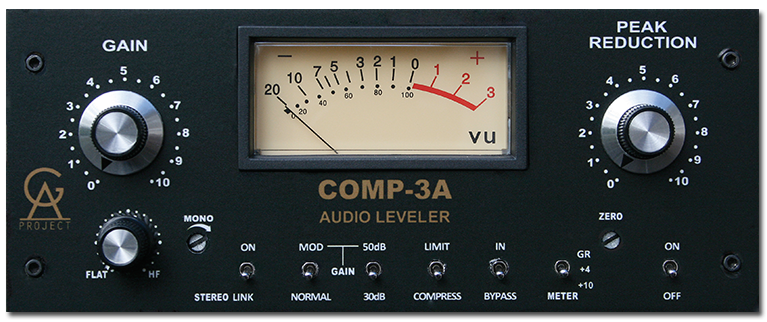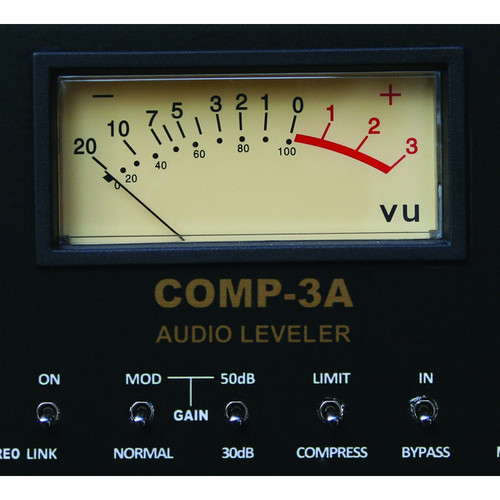New Gear Review: COMP-3A by Golden Age Project
When the opportunity to review the Golden Age Project COMP-3A came up, I was extremely excited to get my hands on it. I’m a big fan of the original LA-3A it is based on, and Golden Age has developed a good reputation for producing quality gear at affordable prices so far.
The designers at GAP are admittedly sentimental about classic gear, and have made it their mission to update vintage designs with modern parts and functionality. To date, they have developed a wide range of mics, preamps, EQs, and of course compressors, and the COMP-3A is a great example of GAP’s ability to get an old dog to do some new tricks.

A closer look at the Golden Age COMP-3A, a solid-state optical limiter descended from the classic LA-2A and LA-3A compressor/limiters.
Features
The COMP-3A is based on the classic UREI LA-3A, a solid state optical compressor first released in the late 1960’s. The controls are very simple, just peak reduction and gain, while attack and release times are program dependent.
Golden Age Project has stayed true to the original design by using only discrete components inside, but have also added a few key features. A variable high pass filter for the sidechain makes the compressor less sensitive to low frequency content while a switchable stereo link can connect to a second unit via a TRS jack on the back panel.
The most notable new controls however, are the gain switches. The COMP-3A comes with a 20dB pad on the input, which is engaged by switching the “50/30” switch to the 30 position. The MOD switch engages a 24dB pad on the output.
With both switches up, the noise floor of the compressor is lower, while keeping the input high and closer to the threshold, resulting in more aggressive compression. This is the setting I used the vast majority of the time, but for more gentle sources you’ll find the less aggressive settings to be very nice and transparent.
In Use
I had a very specific interest in this compressor as I have been using the UAD LA-3A plugin as my vocal compressor for Billy Woods for years. Over the course of 8-9 albums, I’ve tried different things here and there, but have always come back to it. I’ve always loved how it grabbed his vocals; the attack and release of the photocell always seems perfect for his cadence.
I got the COMP-3A just in time to mix the most recent Armand Hammer album ROME, and it sounded fantastic. It’s a bright and forward sounding unit, even with heavy gain reduction, perfect for sitting Woods’ vocals right out front in these dense mixes. Due to the COMP-3A’s simple design, there’s not a lot of fussing around with the settings, and the photocell provides a very musical dynamic movement at all times.
Similar to its predecessor, the COMP-3A also shines on many other sources, particularly electric guitars. It can take tons of compression and still feel powerful and in your face. That is not restricted to heavy rock guitars either; it was great on bright funk guitars and smooth R&B riffs as well.
Of course I had to try it on drums too, however here I had mixed results. The COMP-3A’s inherent brightness resulted in the kick drum not sounding quite as fat as I like, but it was great on snare, and the Mod switches add helpful versatility as well.
The sidechain filter proved handy regardless of the source, keeping low frequencies from affecting the detection circuit in an undesirable way. On bass, I generally love optical compressors. The attack and release times of the photocell always seem just right to me, and here the COMP-3A is no different. However, similar to kick drum, this unit doesn’t have quite as much bottom end as I would want for bass, but using the sidechain filter paired with the right EQ produced a rich and balanced bottom end.
This method also works great for synth leads since they don’t need that low frequency content, and the COMP-3A’s ability to stay bright and forward (even with lots of compression) makes it a great tool for this task.
To Be Critical
Perhaps this criticism doesn’t apply to the COMP-3A alone, but it drives me insane that the peak reduction knob is on the right and the output gain is on the left. I know that’s how it’s always been, and I know it’s no different in the LA-3A’s cousin, the LA-2A. Because we read left to right, I imagine signal flowing from left to right, so this setup feels backwards to me. This is also reflected in the MOD and 50/30 switches, which makes operating them a bit counter intuitive.
Also, the COMP-3A is not exactly neutral in tone. It is definitely a bright compressor, and the gain has a nice but noticeable midrange push. If you’re actively reaching for this kind of tonality, the COMP-3A is a great choice… but if you’re considering it as your first compressor purchase, something with less color might be a more flexible choice.
Summing it Up
Golden Age Project has continued their streak of great modern reinterpretations with the COMP-3A, and in keeping with their reputation of affordability, the unit is fairly priced at only $499. It is evident that the COMP-3A is a well-made, carefully designed tool that produces high quality results consistently. With its bold sound and added features for modern flexibility, the COMP-3A may have found a permanent spot in my vocal chain.
Please note: When you buy products through links on this page, we may earn an affiliate commission.







